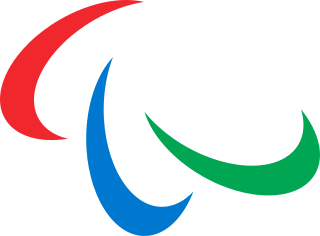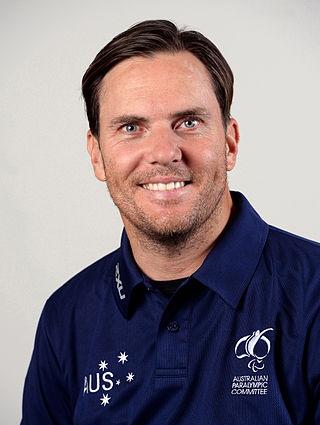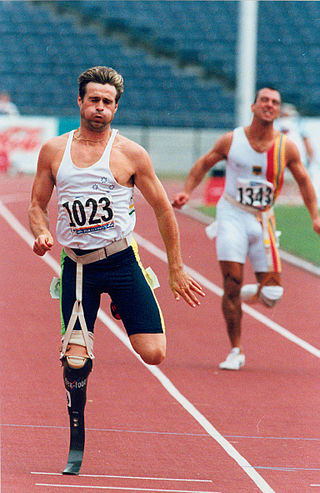
The Rolex Sydney Hobart Yacht Race is an annual event hosted by the Cruising Yacht Club of Australia, starting in Sydney, New South Wales, on Boxing Day and finishing in Hobart, Tasmania. The race distance is approximately 630 nautical miles (1,170 km). The race is run in conjunction with the Royal Yacht Club of Tasmania, and is widely considered to be one of the most difficult yacht races in the world.

The Summer Paralympics also known as the Games of the Paralympiad, are an international multi-sport event where athletes with physical disabilities compete. This includes athletes with mobility disabilities, amputations, blindness, and cerebral palsy. The Paralympic Games are held every four years, organized by the International Paralympic Committee. Medals are awarded in each event, with gold medals for first place, silver for second and bronze for third, a tradition that the Olympic Games started in 1904.

Daniel Fitzgibbon, is an Australian Paralympic sailor, who won a silver medal at the 2008 Summer Paralympics in Beijing. He won gold medals at the 2012 London and 2016 Rio Paralympics with partner Liesl Tesch in the two person SKUD 18.

2 point player and 2.5 point player is a disability sport classification for wheelchair basketball. People in this class have partial trunk control when making forward motions. The class includes people with T8-L1 paraplegia, post-polio paralysis and amputations. People in this class handle the ball less than higher-point players. They have some stability issues on court, and may hold their wheel when trying to one hand grab rebounds.
T42 is a disability sport classification for disability athletics, applying to athletes with single above the knee amputations or a disability that is comparable. This class includes ISOD classified A2 and A9 competitors.
T43 is a disability sport classification for disability athletics, applying to athletes with "Double below knee amputation or similar disability." It includes ISOD classified athletes from the A4 and A9 classes.

T44 is a disability sport classification for disability athletics, applying to "Single below knee amputation or an athlete who can walk with moderately reduced function in one or both legs." It includes ISOD A4 and A9 classes.

T45 is disability sport classification in disability athletics for people with double above or below the elbow amputations, or a similar disability. The class includes people who are ISOD classes A5 and A7. The nature of the disability of people in this class can make them prone to overuse injuries. The classification process to be included in this class has four parts: a medical exam, observation during training, observation during competition and then being classified into this class.

T46 and F46 are disability sport classification for disability athletics. People in this class have a single below or above the elbow amputation. The amputee sports equivalent class is ISOD the A6 and A8 classes. People in this class can have injuries as a result of over use of their remaining upper limb. The classification process to be included in this class has four parts: a medical exam, observation during training, observation during competition and then being classified into this class.
Disability sports classification is a system that allows for fair competition between people with different types of disabilities.
T47 is a disability sport classification for disability athletics primarily for competitors with a below elbow or wrist amputation or impairment. T47 is a classification for track events but unlike the other T40 to T46 classifications it has no equivalent F47 classification for field events. The amputee sports equivalent class is ISOD the A8 class. People in this class can have injuries as a result of over use of their remaining upper limb.
Amputee sports classification is a disability specific sport classification used for disability sports to facilitate fair competition among people with different types of amputations. This classification was set up by International Sports Organization for the Disabled (ISOD), and is currently managed by IWAS who ISOD merged with in 2005. Several sports have sport specific governing bodies managing classification for amputee sportspeople.
A3 is an amputee sport classification used by the International Sports Organization for the Disabled (ISOD) for people with acquired or congenital amputations. A3 classified sportspeople have both legs amputated below knee. Their amputations impact their sport performance, including having balance issues, increased energy costs, higher rates of oxygen consumption, and issues with their gait. Sports people in this class are eligible to participate in include athletics, swimming, sitting volleyball, archery, weightlifting, badminton, lawn bowls, sitzball and wheelchair basketball.
A4 is an amputee sport classification used by the International Sports Organization for the Disabled (ISOD).for people with acquired or congenital amputations. People in this class have one leg amputated below the knee. Their amputations impact their sport performance, including having balance issues, increased energy costs, higher rates of oxygen consumption, and issues with their gait. Sports people in this class are eligible to participate in include athletics, swimming, sitting volleyball, archery, weightlifting, wheelchair basketball, amputee basketball, amputee football, lawn bowls, and sitzball.
A5 is an amputee sport classification used by the International Sports Organization for the Disabled (ISOD).for people with acquired or congenital amputations. A5 sportspeople are people who have both arms amputated above or through the elbow joint. Their amputations impact their sport performance, including being more prone to overuse injuries. Sports people in this class are eligible to participate in include athletics, swimming, cycling, lawn bowls, and sitzball.
A6 is an amputee sport classification used by the International Sports Organization for the Disabled (ISOD) for people with acquired or congenital amputations. People in this class have one arm amputated above or through the elbow joint. Their amputations impact their sport performance, including being more prone to overuse injuries. Sports people in this class are eligible to participate in include athletics, swimming, cycling, amputee basketball, amputee football, lawn bowls, and sitzball.
A7 is an amputee sport classification used by the International Sports Organization for the Disabled (ISOD) for people with acquired or congenital amputations. A7 sportspeople have both arms amputated below the elbow, but through or above the wrist joint. Their amputations impact their sport performance, including being more prone to overuse injuries. Sports people in this class are eligible to participate in include athletics, swimming, cycling, lawn bowls, and sitzball.
A8 is an amputee sport classification used by the International Sports Organization for the Disabled (ISOD).for people with acquired or congenital amputations. People in this class have one arm amputated below the elbow, but through or above the wrist joint. Their amputations impact their sport performance, including being more prone to overuse injuries. Sports people in this class are eligible to participate in include athletics, swimming, cycling, amputee basketball, amputee football, lawn bowls, and sitzball.
A9 is an amputee sport classification used by the International Sports Organization for the Disabled (ISOD).for people with acquired or congenital amputations. People in this class have combination of amputations of the upper and lower extremities. Their amputations impact their sport performance, including energy costs, balance and potential for overuse of muscles. Sports people in this class are eligible to participate in include athletics, swimming, sitting volleyball, amputee basketball, lawn bowls, sitzball and wheelchair basketball.
A1 is an amputee sport classification used by the International Sports Organization for the Disabled (ISOD) for people with acquired or congenital amputations. This class is for sportspeople who have both legs amputated above the knee. Their amputations impact their sport performance, including having balance issues, increased energy costs, higher rates of oxygen consumption, and issues with their gait. Sports people in this class are eligible to participate in include athletics, swimming, sitting volleyball, archery, weightlifting, badminton, lawn bowls, sitzball and wheelchair basketball.











